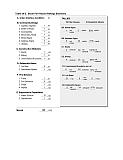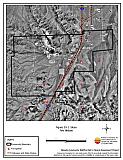34.0 Sloan
34.1 Risk and Hazard Assessment
Sloan is a small community located south of Las Vegas in southern Clark County. The town is situated in the Las Vegas valley and is surrounded by undeveloped Mojave Desert land. The community hazard assessment resulted in classifying Sloan in the Low Hazard category (37 points). Although the community has sparse vegetation, there is no local water source and fire protection services must travel further than 45 minutes round trip for water. A summary of the conditions that contributed to the hazard rating for Sloan is included in Table 5-3 at the end of this section. The Sloan community boundary is shown in Figure 34-1.
34.1.1 Community Design
The area surrounding Sloan is a classic wildland-urban interface condition, with a clear line of demarcation between building structures and wildland fuels. Wildland vegetation typically does not continue into the developed areas. A quarter of the homes were on parcels between one and ten acres in size; the rest of the homes were on lots of less than one acre in size.
- Access: Sloan is accessed by Interstate 15. Several streets lead into the community from these highways. Within Sloan, there is adequate room for fire suppression equipment to maneuver. All roads had less than a five percent gradient.
- Signage: Only one of the six secondary streets in Sloan has a clearly posted street sign. Residential addresses are visible on only one-half of the homes surveyed.
- Utilities: Due to sparse fuels, utilities pose a low ignition risk.
34.1.2 Construction Materials
All of the homes observed in the interface area are built with fire resistant roofing materials and ninety percent have fire resistant siding materials.
One third of the homes in the community have unenclosed balconies, porches, decks, or other architectural features that create drafts and provide areas where sparks and embers can be trapped, smolder, ignite, and rapidly spread fire to the home.
34.1.3 Defensible Space
Eighty-seven percent of the homes observed have landscaping that meets the defensible space landscaping requirement to minimize damage to the home or loss during a wildfire.
34.1.4 Suppression Capabilities
Wildfire Protection Resources
Sloan has no fire department in the community. The closest fire protection services for Sloan would come from Clark County Rural Fire Station 24 in Arden, Henderson Station 99, or Clark County Rural Fire Station 87 in Goodsprings, approximately twenty miles to the south. Goodsprings is an all-volunteer fire department with eight volunteers. Resources that would respond for initial attack of a wildland fire near Sloan are summarized in Table 34-1.
| Type of Resource | Amount of Equipment | Cooperating Partner (Resource Location) |
|---|---|---|
| Type 1 Structure Engine Water Tender Type 6 Quick Attack Engine ILS Rescue |
1 1 1 1 |
Clark County Rural Fire Station 24 (Arden) |
| Type 1 Structure Engine ALS/ILS Rescue Ladder Truck Battalion Chief |
2 1 1 1 |
Clark County Rural Fire (Nearest available) |
| Source: Steve McClintock, pers. comm. April 2004. | ||
Mutual aid can be requested from the US Forest Service and the Bureau of Land Management through the Las Vegas Interagency Communications Center. The Nevada Division of Forestry also provides mutual aid dispatched from the Sierra Front Interagency Dispatch Center in Minden, Nevada, which locates the nearest available fire suppression resource according to incident command and computer aided dispatch protocols. It is important to note that these resources can be assigned to other emergency incidents during the fire season.
Water Sources and Infrastructure
There is no water designated for fire suppression in Sloan. Water for firefighting must be transported and requires over 45 minutes round trip.
Fire Protection Personnel Qualifications
The firefighters have a minimum of NFPA Firefighter I and II training and a limited number of volunteer firefighters have some wildland firefighting training (National Wildfire Coordinating Group 310-1). The National Red Card wildland certification system is used once a volunteer receives the appropriate training.
Community Preparedness
Clark County Fire Department has broad community preparedness and public education programs. The Clark County Emergency Response Plan is updated annually. The Clark County Fire Department reviews development plans to ensure compliance with the 1997 Fire Code.
34.1.5 Factors Affecting Fire Behavior
The vegetative fuel density in the Sloan area is light. Fuel consists primarily of sparse greasewood and creosote bush. The vegetation is generally more robust in the washes than on the fans. Fuel density in this area was estimated to be less than one ton per acre and was considered a low fuel hazard.
The terrain is mostly flat with minimal slope (less than five percent). The predominant wind is from the south/southwest in the late afternoon.
34.1.6 Fire Behavior Worst-case Scenario
The worst-case scenario would occur on an August afternoon with an ignition along Interstate 15 south of Sloan. Strong wind could push a fire through sparse vegetation. There is low fire danger with very low probability of structure loss if minimum defensible space is maintained.
34.1.7 Ignition Risk Assessment
Sloan has a low wildfire ignition risk potential. There is no significant wildfire history reported for the area surrounding the community. Low ignition potential is facilitated by the low, sparse fuels in and around the community.
34.2 Risk and Hazard Reduction Recommendations
The primary recommendation for Sloan is to obtain a water source for fire suppression.
34.2.1 Defensible Space Treatments
Defensible space treatments are an essential first line of defense for residential structures. The goal of the treatments is to significantly reduce or remove flammable vegetation within a prescribed distance from structures. (Refer to Appendix E for the recommended defensible space area) Defensible space reduces the fire intensity and improves firefighter and homeowner chances for successfully defending a structure against oncoming wildfire.
Property Owners
- Remove, reduce, and replace vegetation around homes according to the guidelines in Appendix E. This area should be kept:
- Lean: There are only small amounts of flammable vegetation,
- Clean: There is no accumulation of dead vegetation or other flammable debris,
- Green: Existing plants are healthy and green during the fire season.
- Immediately dispose of cleared vegetation when implementing defensible space treatments. This material dries quickly and poses a fire risk if left on site.
- Maintain this defensible space as needed.
34.2.2 Fire Suppression Resources
Clark County Fire Department
- Install a 5,000 gallon water storage tank for fire suppression.
- Provide all firefighters with basic wildland fire training and equipment as described in the National Wildfire Coordinating Group (NWCG) Wildland and Prescribed Fire Qualification System Guide 310-1. Provide annual wildland firefighting refresher training and fire shelter training.
34.3 Summary of Recommendations
| Involved Party | Recommended Treatment | Recommendation Description |
|---|---|---|
| Property Owners | Defensible Space | Continue to maintain defensible space according to the guidelines in Appendix E. |
| Clark County Fire Department | Fire Suppression Resources | Install a 5,000-gallon water storage tanks for fire suppression. Provide all firefighters with basic wildland fire training and equipment and conduct annual refresher courses. |
Table 34-3. Sloan Wildfire Hazard Rating Summary |
 |
Figure 34-1 Sloan Fire History |
 |
